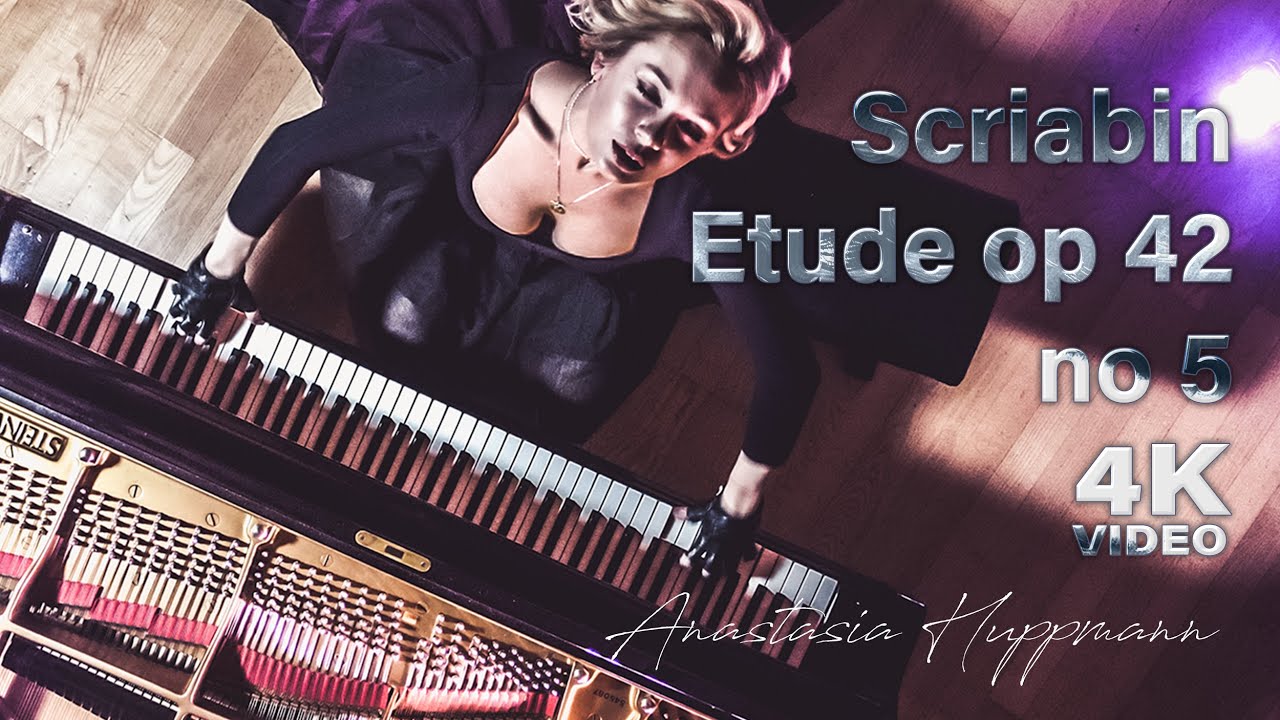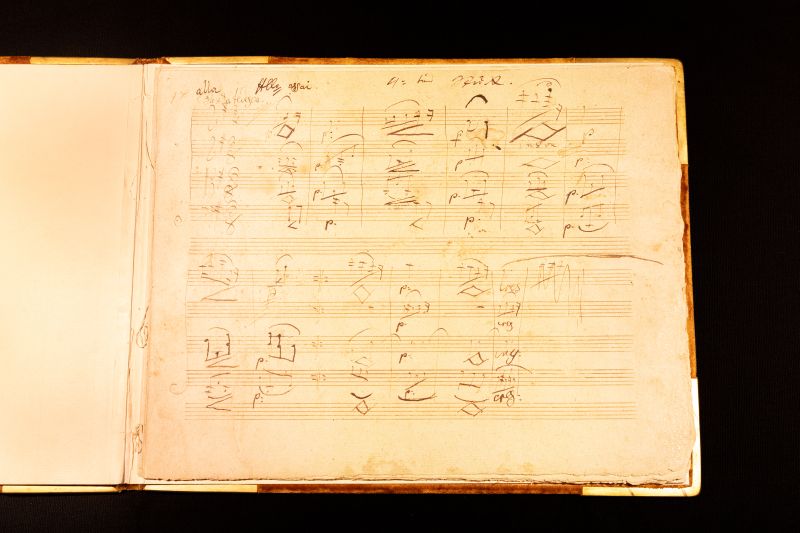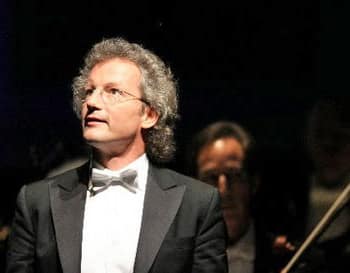So why the Dracula gloves?
mainThe Russian-Austrian pianist Anastasia Huppmann, 32, was to have made her US debut this year.
She can clearly play.
So why the necrophile trappings?


The Russian-Austrian pianist Anastasia Huppmann, 32, was to have made her US debut this year.
She can clearly play.
So why the necrophile trappings?

The autograph manuscript of the fourth movement of…

We have been notified of the passing of…

Franz Welser-Möst has pulled out of the opening…

Elvis If he had lived, Elvis would have…

Session expired
Please log in again. The login page will open in a new tab. After logging in you can close it and return to this page.
“So why the necrophile trappings?”
Because she’s playing Scriabin? 🙂
But not the Black Mass.
Why has the US debut been canceled…does it conflict with this year’s Transylvania Piano Competition?
Rep? Wolf-fang Mozart? Bela Bartok? Ference List-en-to- the children of the night?
DESPERATION. Kind of like this glorified blog looking for news in the midst of ‘Rona.
HA!
Just what the world needs another soft core porn fembot who bangs on the piano, huzzah!
nothing wrong with being a necrophile, some of my favorite people are dead: beethoven, chopin, horowitz…
in this photo, the two things that grabbed your attention were her dracula gloves
Because, as they‘ve been doing for years, the labels will do anything to get your attention. Semi-nudity, weirdness…music as a visual experience while listening abilities plummet all around us.
Lots of pieces, like Stockhausen Klavierstuck X, need gloves.
Perhaps she also plays Drakmaninov!
To not leave marks on Beethoven’s corpse.
Very easy answer, Mr Lebrecht:
Because barefoot, high stilettos, overflowing breasts, mini pubic skirts, backless dresses down to sacrum, etc etc, have already been chosen.
Could you please, Mr Lebrecht, write on female pianists who can also clearly play, like Yeol Eum Son or Beatrice Rana?
Please.
She’s climbing aboard Lola Astanova’s bandwagon.
I assume the gloves are there because critics will then have something to talk about…..
From the musical “Gypsy”:
ELECTRA:
If you wanna make it,
Twinkle while you shake it.
TESSIE TURA:
If you wanna grind it,
Wait till you’ve refined it.
MAZEPPA:
If you wanna stump it,
Bump it with a trumpet!
ALL:
So get yourself a gimmick and you, too,
Can be a star!
I was comparing Anastasia Huppmann’s clothes to the those being worn by members of the Black Dyke band in your earlier post about Zoe Lovatt-Cooper. Ms. Huppmann looks very soberly dressed in comparison. 🙂
maybe she just likes them. you’re such a boring boomer.
everything’s about promotion.
“So why the necrophile trappings?”
Because Halloween is coming up, and she just wanted to have a bit of fun with it.
They might help her play the Mephisto? I had to play in similar, my practise room, as a boy, was so very cold. Perhaps some hellfire might have been an advantage. I wish her well. And you, kind regards.
Have you asked Lola why she dresses the way she does?
Maybe she likes it. Or maybe she thinks it goes along with the mood of the piece. At any rate it sounds fabulous IMHO.
So when women intentionally use their sexual attributes to advance their careers, it’s ok, but if men comment on their intentionally displayed attributes, they are sexist pigs?
I’m always amused that those that say the loudest “Oh, won’t somebody please think of the music” seem to be those least able to look away or shut their eyes.
Since around age 20, Scriabin suffered from a chronic right hand pain that no physician at the time could identify specifically the cause or treat. The general diagnosis was “paresis,’ which was a broad term to identify a general weakness or a partial loss of voluntary movement. Back then, physicians did not distinguish paresis from having pain or no pain.
Dr. Grigory Zakharin, who was a nerve disorder specialist who treated Scriabin, attributed his pain from a horse carriage accident that Scriabin was involved in at age 14, fracturing his right collarbone. He told him that his paresis was incurable, and ordered the ambitious pianist “to abstain from all practicing and prognosticated the end of his career as a public performer.”
After that, Scriabin began to practice playing on the piano with only his left hand, which later affected his future compositions. Scriabin consulted another physician, Dr. Alexander Belyaev, chief physician at the Surgical Clinic of Moscow University, who suggested that the pianist should adopt a “regular and tranquil life, bathing in seawater, and consuming a diet of kumiss.” Apparently, Kumiss is a traditional Tartar and Mongol dairy product that was touted as a cure-all back then.
In May 1895, Scriabin consulted another nerve specialist in Germany, Dr. Wilhelm Erb, who was a professor of nervous disorders at Heidelberg University. His prescription was “hydrotherapy in Switzerland—a four week course of this at Schöneck on Lake Vierwaldstettersee—then a journey through Switzerland and finally sea bathing in Italy,” Scriabin reported. Despite Dr. Erb’s extensive knowledge of the nervous system, his prescription was no more effective than taking kumiss.
The pain did not stop Scriabin from continuing to perform and compose. In fact, his paresis may given his compositions a different flavour than other contemporaries. While his physicians could not give him adequate treatment or care nor was his case , modern understanding of pain and neuroscience provide some clues and hypothesis to why this talented musician had chronic pain.
Neurologist, neuroscientist, and musician Eckart Altenmüller from the Institute of Music Physiology and Musicians’ Medicine at the University of Music Drama and Media in Germany examined some of the treatments and diagnosis that Scriabin’s physicians had made.
He stated that Dr. Zakharin’s diagnosis where Scriabin’s accident have contributed to his paresis at age 14 is correct. “Theoretically, an irritation of the brachial plexus would have been possible shortly after the bone fracture—for example, due to callus tissue accompanying bone healing.”
There were also no reports or evidence that the pain from the injury occurred during past six years before Dr. Zakharin’s diagnosis. Scriabin was able to practice and play without pain during that time. Even if there were some sort of nerve damage or pathology in the brachial plexus, Dr. Erb would not most likely to have missed it. “A compression of the upper fascicle of the brachial plexus, below its passage under the clavicle, would have caused tingling, paresthesia, and muscular atrophy, symptoms which would have never been missed by Professor Erb, who was world famous as specialist for the brachial plexus.”
There was also no evidence that Scriabin had rheumatism because there were no reports of swelling, inflammation, pain in the morning or at night, or rheumatic nodules. Some experts say that Scriabin may have had musician’s dystonia, which is a movement disorder with a loss of voluntary control due to extensive musical practice. However, pain is not usually a symptom of musician’s dystonia, and if Scriabin had that, he would not have been able to write legibly. His notes and composition would resemble spidery scribbles.
Altenmüller identified two symptoms that Scriabin exhibited that may be indicative of myofascial pain syndrome: Dull shifting pain caused by excessive strain on muscles, joints, and other soft connective tissues that get worse with exertion and lack of motor agility with increased muscle tension. Thus, most pianists often get pain in their fingers, wrists, hands, shoulders, and neck. It only occurs when the musicians play their instrument, not while doing other physical activities.
While Scriabin’s quest for a cure for his right hand pain have yielded little benefits, today’s aspiring musicians and healthcare professionals who work with many musicians could learn much from the young Russian artist’s case — from his strive to become the greatest pianist at his time to the course and treatments of the pain that he had experienced.
Understanding the underlying principles of pain could help us get a step closer to find better solutions and communication to our clients and patients. Yet despite Scriabin’s near life-long suffering of pain and delusions, his work is considered as one of the greatest masterpieces that few pianists could emulate. A constant pain could change the homuncular topography, which can distort or exaggerate the normal sensation in a body part — in Scriabin’s case, his right hand.
This change correlates to pain memory and can flare up during music practice. Altenmüller stated that “a crucial part of therapy is to allay the patients’ anxieties in order to break the vicious circle of feeling under threat and prevent the pain from becoming fixed in the pain memory.” He also suggested that musicians with chronic pain should practice no more than ten minutes at a time with several practices a day.
In fact, this is likely why Scriabin’s piano teacher, Vassily Safonoff, had the young student practice less technical and demanding compositions, such as Mozart’s work. He did not tell him to stop practicing or force him to do more than necessary. However, Dr. Zakharin gave young ambitious Scriabin a “death sentence” by telling him that he will never achieve his “high-flying goals, which only increased the pianist’s psychological stress and decrease his pain threshold. Other psychological and sociological factors that likely contributed to his pain would include his financial issues, martial problems, and ability to work under pressure. Scriabin’s fear of failure and “type A” personality may also be major psychological contributing factors.
Why would anyone give you a thumbs down Doc? They must be ejits. Your posts are always fascinating. I once heard you play your harp at St Anne’s.
Sounds like Dr. Erb was a better travel agent than medical doctor.
I used to know someone, long dead, who saw Scriabin play.
This would have been in the last two or three years of the composer’s life. The description of his playing was fascinating, a description corroborated by recordings that have surfaced of Scriabin playing his own music.
There was no mention of him being incapacitated.
Ah, Scriabin’s ninth sonata is nick named “Black Mass”. It requires performers to don gloves worn by Vlad Tepecs which are kept in the Maximillian’s Museum of Curiosities at Schloss Ambras, Innbruck, which also has the only extant portrait of Vlad Tepecs.
A beautiful piece.
My great uncle, a former Master of the Rotunda, founded by Bartholomew Mosse, married the daughter of Dr William Stoker.
Anyone who has read Dracula will be aware of the young Dr Seward, a former pupil of Van Helsing and the administrator of an insane asylum close to Dracula’s English home. However, you may not be aware that Bram Stoker had plenty of inspiration in reality for the character. Stoker was the son of Abraham Stoker, who occupied a high-ranking position in the Chief Secretary’s office in Dublin Castle. Bram had six siblings, three of whom became doctors.
Three of his brothers, William Thornley, Richard Nugent and George, were registered to a practice at 16, Harcourt Street in Dublin in the early 1880s. Richard Nugent Stoker became very involved in the Indian Medical Service while George also served in foreign lands but finally settled in London. William Thornley Stoker was by far the most famous member of the family during his lifetime, achieving a great deal of recognition and distinction for his work in Ireland.
Sir William Thornley Stoker Bart, MD studied in the Royal College of Surgeons in Ireland, Queen’s College, Galway College, Galway and St. Vincent’s Hospital, Dublin. After gaining his MD in 1866 he was appointed to the City of Dublin Hospital. From there, he obtained a surgical position in Richmond Hospital. One article at the time stated, “The result was perfectly unexpected, and has created considerable dissatisfaction among the medical profession in Dublin.” The reasons given for the dissatisfaction were that three of the unsuccessful candidates were already working as lecturers in surgery; Stoker, although working as a tutor, was young and at the time he wasn’t even a Fellow of RCSI. However, within a very short period of time Stoker had become a Fellow of RCSI and had become quite the rising star. During his lifetime he taught students, filled the Chair of Anatomy at RCSI and held the Examinership in Surgery in the Royal University of Ireland.
He was elected President of RCSI from 1894-1896, President of the Royal Academy of Medicine in Ireland from 1903-1905 and was Inspector of Anatomy for Ireland for a time. He also published a large amount of material, a great deal of which is available in Dun’s Library. However, for our purposes, the most interesting aspect of Dr Stoker’s career was his appointment to Swift’s Hospital. Stoker became visiting surgeon here in 1878 and remained in this position until his death in 1912. Swift’s Hospital (also known as St. Patrick’s) was founded by another great Irish literary figure Jonathan Swift and at the time it was a hospital for the insane. Is it possible that the character of Dr Seward is in some-way based on Bram Stoker’s brother?
We do know that there are rumours that Bram Stoker did indeed use real life inspiration for his characters. In fact, many people believe that the titular character, Dracula, is based upon Stoker’s good friend Sir Henry Irving. An obituary for William Thornley Stoker states, “His eldest brother, Mr. Bram Stoker, a man of literary tastes, is secretary to Mr. Irving, the dramatist.” This arrangement came about through another medical acquaintance Dr Henry Maunsell.
Dr Maunsell was educated in Glasgow and upon returning to Ireland he became a Licentiate of RCSI and was elected a Member in 1832. In the same year he was elected Lecturer on Midwifery at the Park-Street Medical School. In 1834 he published The Dublin Practice of Midwifery which was a very influential text, and is also available in Dun’s Library along with other publications by Maunsell. He was clearly very interested in the publication process; in 1839 he established the Dublin Medical Press with Dr Arthur Jacob, and more importantly for this particular post he subsequently purchased the Dublin Evening Mail, to which he devoted himself until his death in 1879.
Maunsell encouraged Bram Stoker to take interest in the theatre and to write reviews for the Dublin Evening Mail. While in this employment, Stoker attended and reviewed (very favourably!) Henry Irving’s Hamlet in the Theatre Royal in Dublin. Having read the review Irving invited Stoker to dine with him and this was to be the beginning of a very productive friendship. Stoker gained employment as Irving’s personal assistant and went on to become acting manager, and following that, business manager of Irving’s Lyceum Theatre in London.
(Doc Martin is a retired GP, amateur composer, antiquarian and Irish harpist based in Belfast).
Why, O Why, were you not my G.P,. whose locum (From another continent) could not understand why I would need to practise four to six hours a day, sighed, and suggested e.c.t.,
You might have prescribed something for my moribund compositions. Stay well and happy 🙂
Maybe thanks, Yes indeed, a locum would make it difficult.
Here is some Turlough O’Carolan, played by a friend who lives in the Kingdom of Kerry.
Lord Inchiquin.
https://www.youtube.com/watch?v=CHuHlY3BBho
Exquisite. Thank you D.M.,Spooky, too. My family is from Tralee
Tralee that is fantastic. Are you satisfied with your current GP? Cov-19 has made it very difficult I know. I used to work on the old contract, I often had to attend folk at 2am in some remote place on the Antrim hills! The waiting lists for first appointment outpatients has sky rocketed. It may well be a case of Quis Paget Entrat.
They are not necrophile trappings, she is in fact wearing Gimp, albeit without a mask and chains.
One can purchase such an outfit at any half descent sex shop or fetish stockist.
I like the idea of a half-descended sex shop. Let me know what they find on the way down.
I think McBreen meant half decent sex shop, it was a typo!
Again, to Anthony Sayer. What you wrote was so evocative of Luis Bunuel. Mere delicacy could no restrain me from the rather vulgar response, please forgive
In sex shop terms, which is supposed to be better: descent, half-descent or indescent?
(To avoid lots of treble, go to a half-descant shop…)